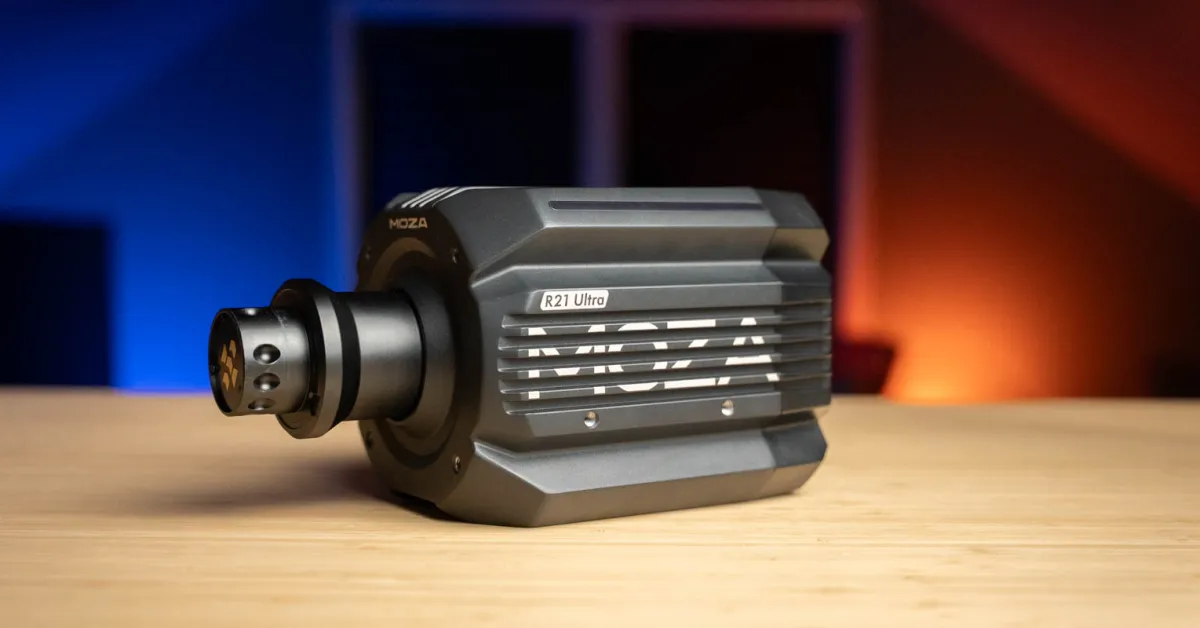Copyright 9to5Toys

Moza’s latest wheel bases top their line-up with the new R25 Ultra and the R21 Ultra, which we have mounted up for testing on the GT Omega Titan cockpit. With up to 21nm of sustained torque and new zero-cogging flat-wire technology, this $700 wheel base marks a new phase in smoothness from one of the more affordable high-power sim racing brands on the market. So, what’s the experience like, and is it worth the price tag? Be sure to hit the video below to find out. In this first look, we’ll examine the design, explore the Moza Pit House app and settings, and share my experiences so far in ACC, iRacing, drifting in AC, AC Evo, and, of course, some Forza Motorsport. Ultimately, by the end, hopefully you will have a good idea of what to expect from the R21 and whether it’s something you should add to your sim rig. I’m going to start by highlighting some of the features, and first up is one of the most noticeable for me: the new zero-cogging flat-wire motor. This was immediately noticeable from the R16. When you just gently rotate the wheel on the older R16 I had been using, there is a slightly notchy feeling, but that is all but gone from the R21 Ultra. If you’re extra careful, you can get just a little bit of a notch, but it’s much better than the R16. Additionally, the R21 Ultra can deliver a constant 21 Nm of torque. Now, I’m not actually going to test that. I have skinny wrists, and I don’t want them to snap. However, it’s more about having the extra headroom that allows the finer details to come through. But if you’re a Hulk-ish monster who wants the full power, the Moza R21 Ultra will be able to deliver. Moza R21 Ultra: Design For the R21 Ultra and R25 Ultra, Moza has abandoned the supercar-inspired design to return to a simpler boxy design that’s more in line with some of its lower-power wheel bases. There are still more rounded edges and details than the R3 and R5, but it’s a departure from the R16. On the back are all of the input ports for pedals, a dashboard, a shifter, a handbrake, and an emergency stop switch. Then, there is a single cord that runs to a PC to connect all of these devices. It’s designed to be easily mounted on a variety of rigs with bottom, front, and side mounting points. I’ve got it mounted on the GT Omega Titan cockpit I’ve been using for about 18 months. Moza R21 Ultra: Video RGB Another interesting, and unnecessary, design feature is the RGB on the sides of the wheel base. You can’t really see it when using a wheel. The only place I could see this being useful is for streamers or content creators, or in a multi-system setup like a sim arcade. It isn’t really for the driver; it’s for the people watching. It has a start-up sequence and can mimic the rev lights on the wheel. My only issue with the design might just highlight an issue with the GT Omega Titan cockpit I’ve been using. The new R21 is shorter from the mounting points to the quick release, which means the wheel is further away from me. I’ve adjusted the wheel as close as possible, and I’ve already maxed out the distance of my pedals, which means I don’t have as much adjustability as I’d like. With the adjustable pedal base, I also notice more flex when I’m hard on the brakes. Eventually, I might need to upgrade. Pit House As always, there are tons of settings to tweak and adjust in Moza’s Pit House software. One of the neat things is the variety of presets that are built in for different sim programs. It’s a good starting point, but you’ll probably still want to make some tweaks. And there are quite a few tweaks. Beyond just turning the strength up and down, there is hand-off protection, max torque output limit, and max wheel speed. Moving over into the advanced tab, there are tweaks for wheel spring strength, gear shift vibration, game inertia, speed-dependent damping, and more. There are also adjustments under the FFB effect equilizer to adjust the feel of the kurbs at different speeds, ABS vibrations, and more. In Pit House, you can also adjust the LED brightness and how it works. By default it uses telemetry to display the RPMs but once again, that’s not really noticeable as the driver. Moza R21 Ultra: Racing experiences Mvoing on to how it feels, one of the most noticeable things is how smooth the flat-wire tech feels. The difference between the entry-level R3 and the Moza R21 is incredible. I hope this tech gets implemented into all wheel bases moving forward. R3 gen 2, anyone? ACC Pit House has built-in presets for a few popular titles, and ACC seemed like one of the best ones to test out the R21. There are two different stock presets for ACC at the moment – Official and one developed from another racer. Both felt great to me, with some of the best tire load feelings that I can remember experiencing in ACC. I had a better grasp of the wheels slipping than I can remember with other wheel bases I’ve used in the past. And there’s plenty of detail for curbs and other on-track feedback. iRacing Beyond just the FFB of the tires and lateral load, iRacing has a ton of LFE that, by default, were too strong on the R21 Ultra. I took the LFE gain down to about -7 and found that to be a fairly sweet spot where it wasn’t vibrating my hands like crazy. AC Drifting Moza has presets for plain AC as well, so I dusted off the old Content Manager and hopped back into the BMW wagon around Clutch Kicker’s Paradise. The smoothness is great for drifting, but in my opinion, it’s way overpowered for this application. I ended up having the power set at 12% when drifting on AC. Of course, your mileage and torque cravings will vary. I’m not sure if pro drifters use high feedback settings, but I often turn it down here. It took me a bit to get used to drifting in AC again, but after a few laps, I felt like I had a good feel for it. AC Evo Some of the most fun I’ve been having recently in any sim is when I’m just bombing around in the E30 in Assetto Corsa Evo. With an older chassis with more flex and roll, you can really take full advantage of the feedback from the wheel. Combined with an H-pattern shifter and pedals, it is one of the most fun experiences I’ve been having lately.The feedback here is incredible; you can really feel the tires load up and react to slip. Forza Motorsport I imagine most people who buy a $700 wheel base aren’t spending as much time playing Forza as I do, but it’s what I have spent the most hours in recently, and the Moza R21 Ultra is a great wheel base for this game. I’ve also spent a lot of hours on the R16 here in Forza, so I can tell what’s different between the wheel bases. There were some new things that I didn’t notice on the R16. Besides smoother and more powerful feedback, there is some intense understeer vibration that lets you know you’re scrubbing the fronts up pretty badly. But the feedback for Forza feels great. Once again, taking some cars with low-level suspension upgrades is a blast. The cars and tail-happy and need a bit more attention that my more competitive, fully-tuned builds, but they’re a blast to drive. Interestingly, Moza doesn’t have a Forza Motorsport preset, but it does have one for Horizon 5. Moza R21 Ulra vs. the competition Lastly, we need to take a look at the pricing of the competition. The R21 Ultra comes in at $700. To get similar power from Fanatec, you’ll need to spend $1,180 for 15 Nm of torque or $1,600 for 25 Nm. From Simagic, you’re looking at $650 for 15 Nm of torque or $900 for 23 Nm. This gets closer to Moza in terms of power for price, but Moza still impresses me with its affordable offerings. 9to5Toys’ Take So if you haven’t realized it yet, I’m loving the Moza R21 Ultra so far. It’s smoother, provides finer detailed feedback, and has crazy power for those who need it – even compared to the R16. I prefer the more refined design, although the RGB aspect is unnecessary. I’ll continue to tweak settings and experiment with iRacing and ACC, and will create a longer-term review after I’ve accumulated more hours. However, even with the limited time I’ve had with the wheel, it feels like a significant upgrade from the R16 I was using previously. And once again, one of the most exciting things for me is the rapid rate at which Moza is releasing new accessories. What takes bigger brands like Logitech what seems like ages, Moza is able to expand upon their offerings at a blistering pace. And in my experience, I haven’t had any quality issues. Across the R3, R5, R16, and now R21 Ultra, I’ve been amazed at the quality. We also have their MBooster active pedal, which I’m testing and will be making a video about in the near future. Make sure to check back for that video. I know I might sound like a shill with all of this praise for Moza, but I’ve honestly had great experiences with all of the sim equipment that I’ve used from them, and I haven’t heard of many issues in the larger sim racing community, either.



